Ahmadiyya

Ahmadiyya

احمدیہ مسلم جماعت | |
| Named after | Muhammad (the Quran has one of his names as Ahmad) |
|---|---|
| Formation | 23 March 1889 |
| Founder | Mirza Ghulam Ahmad |
| Headquarters | Tilford (since 2019), United Kingdom (since 1984) |
Membership | 10–20 million followers |
Leader | Mirza Masroor Ahmad |
| Website | alislam.org [163] |
| Ahmadiyya | |
| Arabic | أحمدية |
| Romanization | Aḥmadīya(t) |
| Literal meaning | fellowship/followers of Aḥmad, i.e., Muhammad; commendation; the state or quality of giving praise |
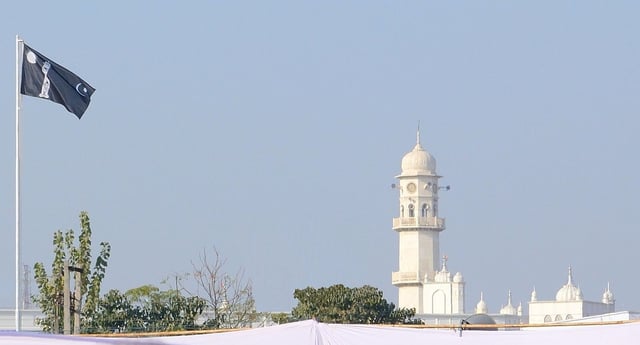
The White Minaret and the Ahmadiyya Flag in Qadian, India. For Ahmadi Muslims, the two symbolize the advent of the Promised Messiah.
Ahmadiyya (UK: /ˌɑːməˈdɪə, ˌæməˈdiːjə/,[1][2][3] US: /ˌɑːməˈdiːə/),[1] officially the Ahmadiyya Muslim Community[4] or the Ahmadiyya Muslim Jama'at (Arabic: الجماعة الإسلامية الأحمدية, romanized: al-Jamāʿah al-Islāmīyah al-Aḥmadīyah; Urdu: احمدیہ مسلم جماعت), is an Islamic revival[5] or messianic[6] movement founded in Punjab, British India, in the late 19th century.[7][8][9][10] It originated with the life and teachings of Mirza Ghulam Ahmad (1835–1908), who claimed to have been divinely appointed as both the promised Mahdi (Guided One) and Messiah expected by Muslims to appear towards the end times and bring about, by peaceful means, the final triumph of Islam;[11][12][13][14] as well as to embody, in this capacity, the expected eschatological figure of other major religious traditions.[15][16] Adherents of the Ahmadiyya—a term adopted expressly in reference to Muhammad's alternative name Aḥmad[17][18][19][20]—are known as Ahmadi Muslims or simply Ahmadis.
Ahmadi thought emphasizes the belief that Islam is the final dispensation for humanity as revealed to Muhammad and the necessity of restoring it to its true intent and pristine form, which had been lost through the centuries.[7] Its adherents consider Ahmad to have appeared as the Mahdi—bearing the qualities of Jesus in accordance with their reading of scriptural prophecies—to revitalize Islam and set in motion its moral system that would bring about lasting peace.[21][22][23] They believe that upon divine guidance he purged Islam of foreign accretions in belief and practice by championing what is, in their view, Islam's original precepts as practised by Muhammad and the early Muslim community.[24][25] Ahmadis thus view themselves as leading the propagation and renaissance of Islam.[26][27]
Mirza Ghulam Ahmad established the Community (or Jamāʿat) on 23 March 1889 by formally accepting allegiance from his supporters. Since his death, the Community has been led by a number of Caliphs and has spread to 210 countries and territories of the world as of 2017 with concentrations in South Asia, West Africa, East Africa, and Indonesia. The Ahmadis have a strong missionary tradition and formed the first Muslim missionary organization to arrive in Britain and other Western countries.[28][29][30][31][32] Currently, the Community is led by its Caliph, Mirza Masroor Ahmad, and is estimated to number between 10 and 20 million worldwide.[33][34][35][36]
The population is almost entirely contained in the single, highly organized and united movement. However, in the early history of the Community, a number of Ahmadis broke away over the nature of Ahmad's prophetic status and succession and formed the Lahore Ahmadiyya Movement for the Propagation of Islam, which today represents a small fraction of all Ahmadis. Some Ahmadiyya-specific beliefs have been thought of as opposed to current conceptions of Islamic orthodoxy since the movement's birth, and some Ahmadis have subsequently faced persecution.[37][36][38][39] Many Muslims consider Ahmadi Muslims as either kafirs or heretics, an animosity sometimes resulting in murder.[40][41][42] The term Qādiyānī is often used pejoratively to refer to the movement and is used in some countries' official documents.[43]
احمدیہ مسلم جماعت | |
| Named after | Muhammad (the Quran has one of his names as Ahmad) |
|---|---|
| Formation | 23 March 1889 |
| Founder | Mirza Ghulam Ahmad |
| Headquarters | Tilford (since 2019), United Kingdom (since 1984) |
Membership | 10–20 million followers |
Leader | Mirza Masroor Ahmad |
| Website | alislam.org [163] |
| Ahmadiyya | |
| Arabic | أحمدية |
| Romanization | Aḥmadīya(t) |
| Literal meaning | fellowship/followers of Aḥmad, i.e., Muhammad; commendation; the state or quality of giving praise |
Naming and etymology
The Ahmadiyya movement was founded in 1889, but the name Ahmadiyya was not adopted until about a decade later. In a manifesto dated 4 November 1900, Mirza Ghulam Ahmad explained that the name did not refer to himself but to Ahmad, the alternative name of Muhammad.[17][20] According to him, the meaning of the name Muhammad—"the most praised one"—indicated the glorious destiny and grandeur of the Islamic prophet that was manifest after the migration to Medina; but Ahmad, an Arabic elative form which means "highly praised" and also "one who praises the most", conveyed the beauty of his sermons, the peace that he was destined to establish, and the qualities of perseverance and forbearance that found particular emphasis during his earlier life at Mecca. According to Ahmad, these two names thus reflected two aspects or modalities of Islam, and in later times it was the latter aspect that commanded greater attention.[19][44][18][45] Labelling a group or school in Islam after anyone (or anything) other than Muhammad the prophet of Islam, he thus rejected as religious innovation (bid‘ah).[46]
Accordingly, in Ahmad's view, this was the reason that the Old Testament had prophesied a messenger like unto Moses, in reference to Muhammad, while according to the Quran 61:6 [164] , Jesus used the elative form Ahmad when referring to that messenger since it reflected his own disposition and circumstances. Further, his reading of Quran 48:29 [165] was that Moses, who himself characterized power and glory, described Muhammad and those with him as unyielding against the disbelievers and tender among themselves which comported with the name Muhammad and with the early Muslims who achieved swift military successes against their oppressors, while Jesus, whose life consisted purely of preaching and involved nothing of might or fighting, described them as like unto a seed-produce that sends forth its sprout, then makes it strong; it then becomes thick and stands firm on its stem. This latter description which, according to him, comported with the name Ahmad, suggested a gradual, measured and peaceful emergence and intimated another community of Muslims: those with the promised Mahdi, the counterpart of Jesus in the latter times.[47] In view of these exegetical rationales, he considered the term Ahmadi—in relation to the incipience of Muhammad's proclamation[18] and in order to distinguish the movement from other Muslim groups[48][49]—as most befitting for himself and the movement:
The name which is appropriate for this Movement and which I prefer for myself and for my Jamā'at is Muslims of the Ahmadiyya Section. And it is permissible that it also be referred to as Muslims of the Ahmadi school of thought.[50]
Lexicology
The term Ahmadiyya—formed by way of suffixation (nisba) from Ahmad and the suffix -iyya(t) (comparable to the English -ness)—is an abstract noun used in reference to the movement itself; while the term Ahmadi (adjectivally denoting affiliation to Ahmad) is a noun used in reference to an adherent of the movement, whether male or female. Despite Ahmadis dissociating the name from their founder, deriving it instead from Islamic prophecy[51] and the name variant of Muhammad,[18] some Sunni Muslims, especially in the Indian subcontinent from where the movement originated, refer to Ahmadis using the pejorative terms Qādiyānī—derived from Qadian, the home town of Ghulam Ahmad; or Mīrzaī—from Mirza, one of his titles.[52][53][54] Both are externally attributed names and are never used by the Ahmadiyya Muslim Community itself.[55]
Summary of beliefs
The Six articles of Islamic Faith and the Five Pillars of Islam constitute the basis of Ahmadi belief and practice. Likewise, Ahmadis accept the Quran as their holy text, face the Kaaba during prayer, follow the sunnah (normative practice of Muhammad) and accept the authority of the ahadith (sing. hadith; reported sayings of and narrations about Muhammad).[56][57][58] In the derivation of Ahmadi doctrine and practice, the Quran has supreme authority followed by the sunnah and the ahadith. Quranic rulings cannot be overruled by any other secondary or explanatory source. If a hadith is found to be in manifest conflict with the Quran and defies all possible efforts at harmonization, it is rejected regardless of the classification of its authenticity.[59][60] Their acceptance of the authority of the four Rightly Guided caliphs (successors) as legitimate leaders of the Muslim community following Muhammad's death and their belief that a caliph need not be a descendant of Muhammad fundamentally aligns Ahmadis with the Sunni tradition of Islam rather than with the Shi'a tradition. In matters of fiqh (Islamic jurisprudence), Ahmadis reject strict adherence (taqlid) to any particular school of thought (madhhab), giving foremost precedence to the Quran and sunnah, but usually base their rulings on the Hanafi methodology in cases where these sources lack clear elaboration.[61][62][63][64][65] What essentially distinguishes Ahmadi Muslims from other Muslims is their belief in Mirza Ghulam Ahmad, the founder of the movement, as both the promised Mahdi (Guided One) and Messiah foretold by Muhammad to appear in the end times. Summarising his claim, Ahmad writes:
The task for which God has appointed me is that I should remove the malaise that afflicts the relationship between God and His creatures and restore the relationship of love and sincerity between them. Through the proclamation of truth and by putting an end to religious conflicts, I should bring about peace and manifest the Divine verities that have become hidden from the eyes of the world. I am called upon to demonstrate spirituality which lies buried under egoistic darkness. It is for me to demonstrate by practice, and not by words alone, the Divine powers which penetrate into a human being and are manifested through prayer or attention. Above all, it is my task to re-establish in people’s hearts the eternal plant of the pure and shining Unity of God which is free from every impurity of polytheism, and which has now completely disappeared. All this will be accomplished, not through my power, but through the power of the Almighty God, Who is the God of heaven and earth.[66]
In keeping with this, he believed his objective was to defend and propagate Islam globally through peaceful means, to revive the forgotten Islamic values of peace, forgiveness and sympathy for all mankind, and to establish peace in the world through the teachings of Islam. He believed that his message had special relevance for the Western world, which, he believed, had descended into materialism.[67]
Ahmadi teachings state that all the major world religions had divine origins and were part of the divine plan towards the establishment of Islam as the final religion, because it was the most complete and perfected the previous teachings of other religions[68] (but they believe that all other religions have drifted away from their original form and have been corrupted). The message which the founders of these religions brought was, therefore, essentially the same as that of Islam, albeit incomplete. The completion and consummation of the development of religion came about with the advent of Muhammad. However, the global conveyance, recognition and eventual acceptance of his message (i.e. the perfection of the manifestation of Muhammad's prophethood) was destined to occur with the coming of the Mahdi.[69] Thus, Ahmadi Muslims regard Mirza Ghulam Ahmad as that Mahdi and, by extension, the "Promised One" of all religions fulfilling eschatological prophecies found in the scriptures of the Abrahamic religions, as well as Zoroastrianism, the Indian religions, Native American traditions and others.[70] Ahmadi Muslims believe that Ahmad was divinely commissioned as a true reflection of Muhammad's prophethood to establish the unity of God and to remind mankind of their duties towards God and His creation.[71][72] Summarising the Islamic faith, Ahmad writes:
There are only two complete parts of faith. One is to love God and the other is to love mankind to such a degree that you consider the suffering and the trials and tribulations of others as your own and that you pray for them.[73]
Articles of faith
Ahmadi Muslims subscribe to the same beliefs as the majority of Muslims, but with a difference of opinion on the meaning of Khatam an-Nabiyyin. The six articles of faith are identical to those believed in by Sunni Muslims, and are based on the Quran and traditions of Muhammad:
Unity of God
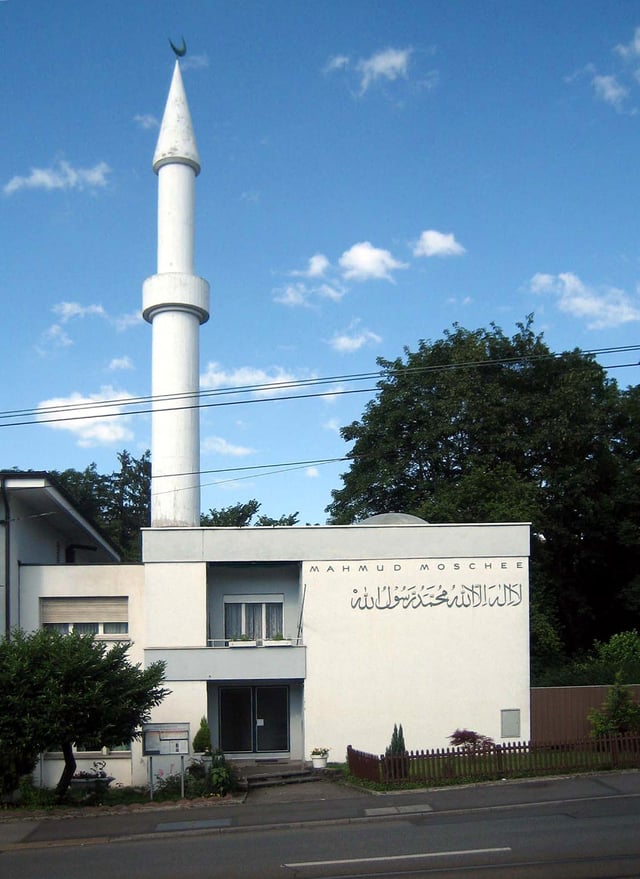
The Shahada, outside the Mahmood Mosque in Zurich, proclaiming the oneness of God
Ahmadi Muslims firmly believe in the absolute Unity of God. Acknowledgement of this principle is the most important and the cardinal principle of Islam as interpreted by the Community. All other Islamic beliefs spring from this belief. The belief in the Unity of God is thought to influence a person's life in all its aspects and is believed to have much wider meaning and deeper applications. For example, elaborating on the Oneness of God, the Quranic verse "There is no all-encompassing power except God" is believed to negate all forms of fear with the exception of the fear of God. It instills a sense of complete dependence on God and that every good emanates from Him. In general, the belief in unity of God is thought to liberate believers from all forms of carnal passions, slavery and perceptions of earthly imprisonment. The founder of the Community writes:
The Unity of God is a light which illumines the heart only after the negation of all deities, whether they belong to the inner world or the outer world. It permeates every particle of man's being. How can this be acquired without the aid of God and His Messenger? The duty of man is only to bring death upon his ego and turn his back to devilish pride. He should not boast of his having been reared in the cradle of knowledge but should consider himself as if he were merely an ignorant person, and occupy himself in supplications. Then the light of Unity will descend upon him from God and will bestow new life upon Him.[74]
It is further believed that the Islamic concept of Oneness of God inculcates the realization of the Oneness of the human species and thus removes all impediments in this regard. The diversity of all human races, ethnicities and colours are considered worthy of acceptance. Moreover, it is thought that a belief in the Unity of God creates a sense of absolute harmony between the Creator and the creation. It is understood that there can be no contradiction between the word of God and work of God.[75][76]
Islam recognises God as the fountain-head of all excellences, free from all imperfection as understood by the Community. God is recognised as a Living God who manifests himself everywhere and listens to the prayers of his servants. Distinctively, however, Ahmadi Muslims recognise that the attributes of God are eternal. On account of this, Ahmadi teachings propound the view that God communicates with mankind as he did before.
Angels
The belief in angels is fundamental to the Ahmadiyya Muslim Community. They are spiritual beings created by God to obey him and implement his commandments. Unlike human beings, angels have no free will and cannot act independently. Under God's command, they bring revelations to the Prophets, bring punishment on the Prophets' enemies, glorify God with his praise, and keep records of human beings' deeds. Angels are not visible to the physical eye. Yet, according to the Ahmadiyya Muslim Community, they do sometimes appear to man in one form or another. This appearance, however, is not physical but a spiritual manifestation.[77] Ahmadi Muslims regards angels as celestial beings who have their own entity as persons. The major role they play is the transmission of messages from God to human beings. According to the Quran, the entire material universe as well as the religious universe is governed by some spiritual powers, which are referred to as angels. Whatever they do is in complete submission to the Will of God and the design that he created for things. According to Islam, as interpreted by Ahmadi Muslims, they cannot deviate from the set course or functions allocated to them, or from the overall plan of things made by God.[78]
Books
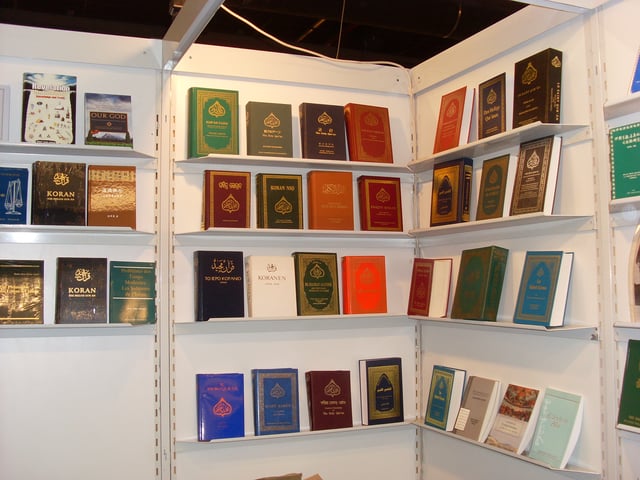
Some of the many Quran translations by Ahmadi translators at the 2009 Frankfurt Book Fair
For Ahmadi Muslims, the third article in Islam is concerned with the belief in all the divine scriptures as revealed by God to his Prophets. This includes, the Torah, the Gospel, the Psalms, the scrolls of Abraham, and the Quran. Before the advent of Islam, the history of religion is understood as a series of dispensations where each messenger brought teachings suitable for the time and place. Thus, at the time of their inception, the divine teachings sent by God concurred in their fundamentals, with the exception of minor details that were chosen to complement the time and place. With the exception of the Quran, it is believed that the divine scriptures are susceptible to human interpolation. Islam recognises that God sent his prophets to every nation and isolated communities of the world. Thus, according to the Ahmadi teachings, books outside of the Abrahamic tradition, such as the Vedas and Avesta are too considered as being of divine origin. Among the recognised books, the Community believes that the Quran is the final divine scripture revealed by God to mankind. The teachings of the Quran are considered timeless.[79]
Prophets
According to the Ahmadi Muslim view, the fourth article of faith in Islam is concerned with the belief in all divine prophets sent by God. Ahmadi Muslims believe that when the world is filled with unrighteousness and immorality, or when a specific part of the world displays these attributes, or when the followers of a certain law (religion) become corrupt or incorporate corrupted teachings into the faith, thus making the faith obsolete or in need of a Divine Sustainer, then a Prophet of God is sent to re-establish His Divine Will. Aside from the belief in all prophets in the Quran and the Old Testament, the Community also regards Zoroaster, Krishna, Buddha, Confucius as prophets.[80]
According to the Ahmadiyya belief, the technical Islamic terms "warner" (natheer), "prophet" (nabi), "messenger" (rasul) and "envoy" (mursal) are synonymous in meaning. However, there are two kinds of prophethood as understood by the Community: Law-bearing prophets, who bring a new law and dispensation, such as Moses (given the Torah) and Muhammad (given the Quran); and non-law-bearing prophets, who appear within a given dispensation such as Jeremiah, Jesus and Mirza Ghulam Ahmad. Adam is regarded as the first human with whom God spoke with and revealed to him his divine will and thus the first prophet but is not regarded as the first human on earth by the Ahmadiyya Muslim Community, contrary to mainstream Islamic, Jewish and Christian beliefs. This view is based on the Quran itself, according to the Ahmadiyya Muslim Community.[81] Ahmadis believe Muhammad to be the final law-bearing prophet but teach the continuity of prophethood.
Day of Judgement
The fifth article of faith relates to the Day of Judgment.[82] According to the Ahmadis, after belief in one God, belief in the Day of Judgement is the most emphasized doctrine mentioned in the Quran.[82] According to Ahmadi Muslim beliefs, the entire universe will come to an end on the Day of Judgment, a position also taken by all other Islamic sects and schools of thought. The dead will be resurrected and accounts will be taken of their deeds. People with good records will enter into Heaven while those with bad records will be thrown into Hell.[82] Hell is understood in Ahmadiyya as a temporary abode, lasting an extremely long time but not everlasting, much like in mainstream Judaism. It is thought to be like a hospital, where souls are cleansed of their sins, and this view is based on the Quran and Hadith.[83]
Divine decree
The Ahmadiyya Muslim Community believes that divine decree controls the eventual outcome of all actions in this universe. Within the boundaries of divine decree, man is given free will to choose the course.[84] Ahmadi Muslims believe that they will be judged on the basis of their intentions and deeds on the Day of Judgment. Ahmadis believe that science is the study of the acts of God and religion is the study of the word of God and the two cannot possibly contradict each other. They believe that Adam, the prophet, was simply the first Prophet and not the first human on earth, as understood by them being in the Quran. Ahmadi Muslims do believe in the theory of biological evolution, albeit guided by God.
Five pillars
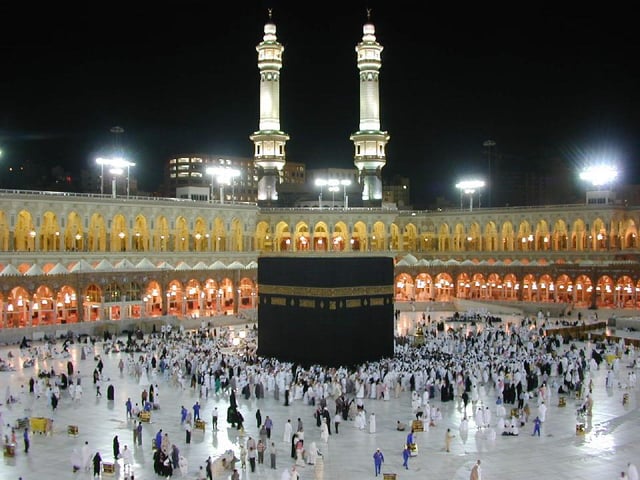
Though many Ahmadi Muslims perform Hajj, they are not permitted by Saudi law.
The Pillars of Islam (arkan al-Islam; also arkan ad-din, "pillars of religion") are five basic acts in Islam, considered obligatory for all Ahmadi Muslims.[85] The Quran presents them as a framework for worship and a sign of commitment to the faith. They are (1) the shahadah (creed), (2) daily prayers (salat), (3) almsgiving (zakah), (4) fasting during Ramadan and (5) the pilgrimage to Mecca (hajj) at least once in a lifetime.[86] Ahmadi Muslims agree with both Shia and Sunni sects on the essential details for the performance of these acts. However, in Pakistan Ahmadi Muslims are prohibited by law, and to some extent in other Muslim countries by persecution, from self-identifying as Muslims. This creates some level of difficulty in performing the obligatory acts. Although Ahmadi Muslims from some countries do perform the pilgrimage to Mecca, they are not allowed under Saudi law.[87]
Distinct teachings
Although the Five Pillars of Islam and the six articles of belief of Ahmadi Muslims are identical to those of mainstream Sunni Muslims and central to Ahmadi belief,[88] distinct Ahmadiyya beliefs include the following:
Second Coming

The White Minaret in Qadian, India. For Ahmadi Muslims, it symbolizes the advent of the Promised Messiah and the ultimate preeminence of Islam
Contrary to mainstream Islamic belief, Ahmadi Muslims believe that Jesus was crucified and survived the four hours on the cross. He was later revived from a swoon in the tomb.[89] Ahmadis believe that Jesus died in Kashmir of old age whilst seeking the Lost Tribes of Israel.[90] Jesus' remains are believed to be entombed in Kashmir under the name Yuz Asaf. In particular, it is believed that the biblical and the Islamic prophecies concerning the second coming of Jesus were metaphorical in nature and not literal, and that Mirza Ghulam Ahmad fulfilled in his person these prophecies and the second advent of Jesus. Ahmadi Muslims also believe that the "Promised Messiah" and the "Imam Mahdi" are the same person, and that it is through his teachings, influence and prayers and those of his followers that Islam will defeat the Anti-Christ or Dajjal in a period similar to the period of time it took for nascent Christianity to rise (see also: Ahmadiyya relationship with Christianity) and that the Dajjal's power will slowly fade away, heralding the prophecised final victory of Islam and the age of peace.
Seal of Prophets
Although Ahmadi Muslims believe that the Quran is the final message of God for mankind, they also believe that God continues to communicate with his chosen individuals in the same way he is believed to have done in the past. All of God's attributes are eternal. In particular, Ahmadi Muslims believes that Muhammad brought prophethood to perfection and was the last law-bearing prophet and the apex of humankind's spiritual evolution. New prophets can come, but they must be completely subordinate to Muhammad and will not be able to exceed him in excellence nor alter his teaching or bring any new law or religion. They are also thought of as reflections of Muhammad rather than independently made into Prophets, like the Prophets of antiquity.[91]
Jihad
According to Ahmadi Muslim belief, Jihad can be divided into three categories: Jihad al-Akbar (Greater Jihad) is that against the self and refers to striving against one's low desires such as anger, lust and hatred; Jihad al-Kabīr (Great Jihad) refers to the peaceful propagation of Islam, with special emphasis on spreading the true message of Islam by the pen; Jihad al-Asghar (Smaller Jihad) is an armed struggle only to be resorted to in self-defence under situations of extreme religious persecution whilst not being able to follow one's fundamental religious beliefs, and even then only under the direct instruction of the Caliph.[92] Ahmadi Muslims point out that as per Islamic prophecy, Mirza Ghulam Ahmad rendered Jihad in its military form as inapplicable in the present age as Islam, as a religion, is not being attacked militarily but through literature and other media, and therefore the response should be likewise.[93] They believe that the answer of hate should be given by love.[94]
Concerning terrorism, the fourth Caliph of the Community wrote in 1989:
As far as Islam is concerned, it categorically rejects and condemns every form of terrorism. It does not provide any cover or justification for any act of violence, be it committed by an individual, a group or a government.[95]
Abrogation
Unlike most scholars of other Islamic sects,[96][97][98] Ahmadi Muslims do not believe that any verses of the Quran abrogate or cancel other verses. All Quranic verses have equal validity, in keeping with their emphasis on the "unsurpassable beauty and unquestionable validity of the Qur'ān".[99] The harmonization of apparently incompatible rulings is resolved through their juridical deflation in Ahmadī fiqh, so that a ruling (considered to have applicability only to the specific situation for which it was revealed), is effective not because it was revealed last, but because it is most suited to the situation at hand.[99]
Religion and science
Ahmadi Muslims believe that there cannot be a conflict between the word of God and the work of God, and thus religion and science must work in harmony with each other.[100] With particular reference to this relationship, the second Caliph of the Ahmadiyya Muslim Community states that in order to understand God's revelation, it is necessary to study His work, and in order to realize the significance of His work, it is necessary to study His word.[101] According to the Nobel laureate, Abdus Salam, a devout Ahmadi Muslim, 750 verses of the Quran (almost one eighth of the book) exhort believers to study Nature, to reflect, to make the best use of reason in their search for the ultimate and to make the acquiring of knowledge and scientific comprehension part of the community's life.[102]
Cyclical nature of history
A final distinct beliefs is the notion that the history of religion is cyclic and is renewed every seven millennia. The present cycle from the time of the Biblical Adam is split into seven epochs or ages, parallel to the seven days of the week, with periods for light and darkness. Mirza Ghulam Ahmad appeared as the promised Messiah at the sixth epoch heralding the seventh and final age of mankind,[103] as a day in the estimation of God is like a thousand years of man's reckoning.[Quran 22:47 [166] ] According to Ghulam Ahmad, just as the sixth day of the week is reserved for Jumu'ah (congregational prayers), likewise his age is destined for a global assembling of mankind in which the world is to unite under one universal religion: Islam.
History
Ahmadiyya timeline | |
|---|---|
| 1882 | Mirza Ghulam Ahmad (without publicity) claims to be the Mujaddid of the fourteenth Islamic century |
| 1889 | Mirza Ghulam Ahmad establishes the Ahmadiyya Muslim movement |
| 1890 | Mirza Ghulam Ahmad announces his claim to 'The Promised Messiah' and 'The Imam Mahdi' of the Latter days |
| 1908 | Mirza Ghulam Ahmad dies in Lahore. Hakeem Noor-ud-Din is elected as the First Caliph |
| 1914 | Mirza Basheer-ud-Din Mahmood Ahmad is elected as the Second Caliph |
| 1947 | Mirza Basheer-ud-Din Mahmood Ahmad migrates to Lahore, Pakistan |
| 1948 | Mirza Basheer-ud-Din Mahmood Ahmad establishes the city of Rabwah as the new headquarters of the Community |
| 1965 | Mirza Nasir Ahmad is elected as the Third Caliph |
| 1982 | Mirza Tahir Ahmad is elected as the Fourth Caliph |
| 1984 | Mirza Tahir Ahmad migrates to London, England, moving the headquarters to London |
| 2003 | Mirza Masroor Ahmad is elected as the Fifth Caliph |
| 2019 | The headquarters of the Ahmadiyya Muslim Community is moved from the Fazl Mosque in Southfields, London to Islamabad in Tilford, Surrey |
Formally, the history of the Ahmadiyya Muslim Community begins when Mirza Ghulam Ahmad took the oath of allegiance from a number of his companions at a home in Ludhiana, India, on 23 March 1889. However, the history can be taken back to the early life Ahmad, when he reportedly started receiving revelations concerning his future, but also as far back as the traditions of various world religions. At the end of the 19th century, Mirza Ghulam Ahmad of Qadian proclaimed himself to be the "Centennial Reformer of Islam" (Mujaddid), metaphorical second coming of Jesus and the Mahdi (guided one) awaited by the Muslims and obtained a considerable number of followers especially within the United Provinces, the Punjab and Sindh.[104] He and his followers claim that his advent was foretold by Muhammad, the Prophet of Islam, and also by many other religious scriptures of the world. Ahmadiyya emerged in India as a movement within Islam, also in response to the Christian and Arya Samaj missionary activity that was widespread in the 19th century.
The Ahmadiyya faith claims to represent the latter-day revival of the religion of Islam. Overseas Ahmadiyya missionary activities started at an organized level as early as 1913 (for example, the UK mission in Putney, London). For many modern nations of the world, the Ahmadiyya movement was their first contact with the proclaimants from the Muslim world.[105] The Ahmadiyya movement is considered by some historians[106] as one of the precursors to the Civil Rights Movement in America. According to some experts,[107] Ahmadiyya were "arguably the most influential community in African-American Islam" until the 1950s. Today, the Ahmadiyya Muslim Community has one of the most active missionary programs in the world. It is particularly large in Africa. In the post colonial era, the Community is credited for much of the spread of Islam in the continent.[108]
First Caliphate
After the death of Mirza Ghulam Ahmad, Hakeem Noor-ud-Din was unanimously elected as his first successor and Caliph of the Community. Within the stretch of his Caliphate, a period which lasted six years, he oversaw a satisfactory English translation of the Quran, the establishment of the first Ahmadiyya Muslim mission in England and the introduction of various newspapers and magazines of the Community. As a result of growing financial requirements of the Community, he set up an official treasury. Most notably, however, he dealt with internal dissensions, when a number high-ranking office bearers of the Ahmadiyya Council disagreed with some of the administrative concepts and the authority of the Caliph.
Second Caliphate

The Ahmadiyya Muslim Community Flag, first designed in 1939, during the Second Caliphate
Soon after the death of the first caliph, Mirza Basheer-ud-Din Mahmood Ahmad was elected as the second caliph, in accordance with the will of his predecessor. However, a faction led by Maulana Muhammad Ali and Khwaja Kamal-ud-Din strongly opposed his succession and refused to accept him as the next caliph, which soon led to the formation of the Lahore Ahmadiyya Movement. This was due to certain doctrinal differences they held with the caliph such as the nature of Mirza Ghulam Ahmad's prophethood and succession.[109] It has also been theorised that a clash of personalities with that of the dissenters and the caliph himself, who had a relatively poor academic background, also played a role.[110] However, the Lahore Ahmadiyya movement, which settled in Lahore, has had relatively little success and has failed to attract a sizeable following.[111] In the history of the Community, this event is referred to as 'The Split' and is sometimes alluded to a prophecy of the founder.
Elected at a young age, Mahmood Ahmad's Caliphate spanned a period of almost 52 years. He established the organizational structure of the Community and directed extensive missionary activity outside the subcontinent of India. Several weeks following his election, delegates from all over India were invited to discuss about propagation of Islam. Two decades later, Mahmood Ahmad launched a twofold scheme for the establishment of foreign missions and the moral upbringing of Ahmadi Muslims. The Tehrik-e-Jedid and Waqf-e-Jedid or the 'new scheme' and the 'new dedication' respectively, initially seen as a spiritual battle against the oppressors of the Ahmadi Muslims, called upon members of the Community to dedicate their time and money for the sake of their faith. In time the scheme produced a vast amount of literature in defence of Islam in general and the Ahmadiyya beliefs in particular. The funds were also spent on the training and dispatching of Ahmadi missionaries outside the Indian sub-continent.[112]
During his time, missions were established in 46 countries, mosques were constructed in many foreign countries and the Quran published in several major languages of the world. Although the Community continued to expand in the course of succeeding Caliphates, sometimes at a faster pace, the second caliph is credited for much of its inception. Ahmad wrote many written works, the most significant of which is the ten volume commentary of the Quran.[112]
Third Caliphate
Elected on 8 November 1965, Mirza Nasir Ahmad succeeded as the third Caliph of the Ahmadiyya Muslim Community. Started by his predecessor, he is credited with the expansion of the missionary work, particularly in Africa, and is seen as having shown great leadership and guidance to the Community during the period when the National Assembly of Pakistan declared the Community as a non-Muslim minority.[113][114] Nusrat Jahan Scheme, a scheme dedicated to serving parts of Africa by running numerous medical clinics and schools was one of the many outcomes of his 1970 tour of West Africa, regarded as the first ever visit to the continent made by an Ahmadi Caliph. During his visit for the foundation stone ceremony of the Basharat Mosque, the first mosque in modern Spain, he coined the popular Ahmadiyya motto: Love for all, Hatred for None.[115][116]
Mirza Nasir Ahmad established the Fazl-e-Umar Foundation in honour of his predecessor, oversaw the compilations of dialogues and sayings of the founder of the Community, Mirza Ghulam Ahmad, and also directed the complete collection of the dreams, visions and verbal revelations claimed to have been received by the founder.[113]
Fourth Caliphate
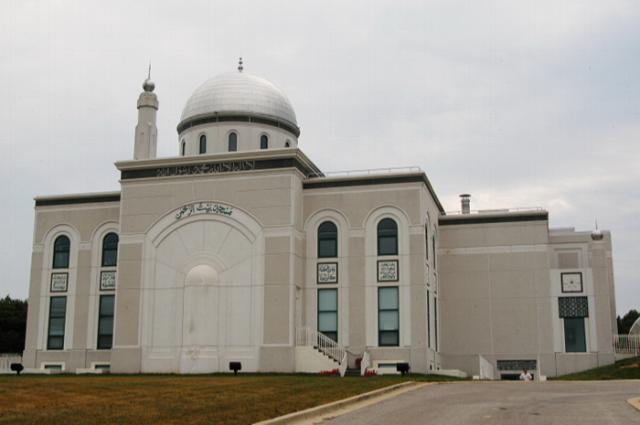
Baitur Rehman Mosque near Washington, D.C. is one of several mosques inaugurated by the fourth caliph
Mirza Tahir Ahmad was elected as the fourth Caliph of the Ahmadiyya Muslim Community on 10 June 1982, a day after the death of his predecessor. Following the Ordinance XX that was promulgated by the government of Pakistan in 1984, which rendered the Caliph unable to perform his duties and put the very institution in jeopardy, Ahmad left Pakistan and migrated to London, England, moving the headquarters of the Community to Fazl Mosque, the first mosque in London.[117] For Ahmadi Muslims, the migration marked a new era in the history of the Community. Ahmad launched the first Muslim satellite television network, Muslim Television Ahmadiyya;[118] instituted the Waqfe Nau Scheme, a program to dedicate Ahmadi Muslim children for the services of the Community; and inaugurated various funds for humanitarian causes such as the Maryum Shaadi Fund, the Syedna Bilal Fund, for victims of persecution, and the disaster relief charity Humanity First.[118]
To the Community, Ahmad is noted for his regular Question & Answer Sessions he held in multiple languages with people of various faiths, professions and cultural backgrounds. However, Ahmad also wrote many books – the most significant of which include Islam's Response to Contemporary Issues, Murder in the name of Allah, Absolute Justice, Kindness and Kinship, Gulf Crisis and The New World Order and his magnum opus[119] Revelation, Rationality, Knowledge & Truth.
Fifth Caliphate
Following the death of the fourth Caliph in 2003, the Electoral College for the first time in the history of the Community convened in the western city of London, after which Mirza Masroor Ahmad was elected as the fifth and current Caliph of the Ahmadiyya Muslim Community. In his effort to promote his message of peace and facilitate service to humanity, Ahmad travels globally meeting heads of state, holding peace conferences, and exhibiting Islamic solutions to world problems.[120] In response to ongoing conflicts, Ahmad has sent letters to world leaders, including Queen Elizabeth and Pope Francis. Being the spiritual head of millions of Ahmadi Muslims residing in over 200 countries and territories of the world, Ahmad travels globally, teaching, conveying and maintaining correspondence with communities of believers and individuals, expounding principles of the Islamic faith.
Demographics

Ahmadiyya Muslim population map.
As of 2016 the community has been established in 209 countries and territories of the world with concentrations in South Asia, West Africa, East Africa, and Indonesia. The community is a minority Muslim sect in almost every country of the world.[121] In some countries like Pakistan, it is practically illegal to be an Ahmadi Muslim.[122] Together, these factors make it difficult to estimate the Ahmadiyya population for both the community itself as well as independent organizations. For this reason, the community gives a figure of "tens of millions";[123] however, most independent sources variously estimate the population to be at least 10 to 20 million[124] worldwide, thereby representing around 1% of the world's Muslim population.[125] In 2001, the World Christian Encyclopedia, estimated that the Ahmadiyya movement was the fastest growing sect within Islam.[126] It is estimated that the country with the largest Ahmadiyya population is Pakistan, with an estimated 4 million Ahmadi Muslims. The population is almost entirely contained in the single, organized and united movement, headed by the Caliph. The other is the Lahore Ahmadiyya Movement, which represents less than 0.2% of the total Ahmadiyya population.[111] Ahmadiyya are estimated to be from 60,000 to 1 million in India.[127]
Organizational structure
The Caliph
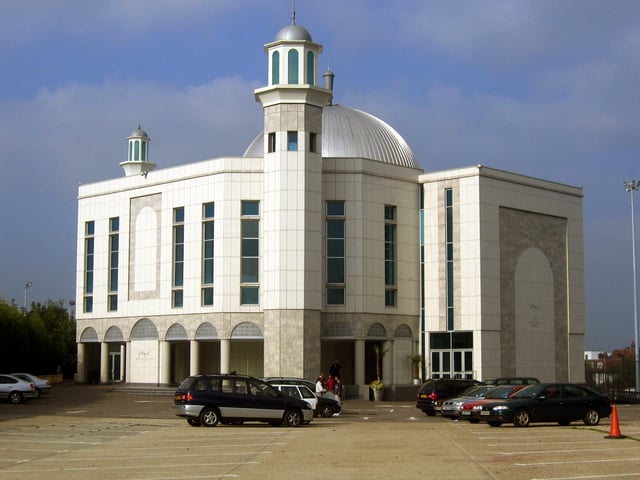
Baitul Futuh Mosque, one of the largest mosques in Europe. The Caliph's Friday Sermon is televised live throughout the world, via MTA TV
Ahmadi Muslims believe that the Ahmadiyya caliphate is the resumption of the Rightly Guided Caliphate. This is believed to have been re-established with the appearance of Mirza Ghulam Ahmad whom Ahmadis believe was the promised Messiah and Mahdi. Ahmadi Muslims maintain that in accordance with Quranic verses (such as [Quran 24:55 [167] ]) and numerous Hadith on the issue, Khilāfah or the Caliphate can only be established by God Himself and is a divine blessing given to those who believe and work righteousness and uphold the unity of God. Therefore, any movement to establish the Caliphate centred around human endeavours alone is bound to fail, particularly when the condition of the people diverges from the precepts of prophethood and they are as a result disunited, their inability to elect a caliph caused fundamentally by the lack of righteousness in them. It is believed that through visions, dreams and spiritual guidance, God instils into the hearts and minds of the believers of whom to elect. No campaigning, speeches or speculation of any kind are permitted. Thus the caliph is designated neither necessarily by right (i.e. the rightful or competent one in the eyes of the people) nor merely by election but primarily by God.[128]
According to Ahmadiyya thought, it is not essential for a caliph to be the head of a state, rather the spiritual and religious significance of the Caliphate is emphasised. It is above all a spiritual office, with the purpose to uphold, strengthen, spread the teachings of Islam and maintain the high spiritual and moral standards within the global community established by Muhammad. If a caliph does happen to bear governmental authority as a head of state, it is incidental and subsidiary in relation to his overall function as a caliph.[129][130] The caliph is also referred to by Ahmadi Muslims as Amir al-Mu'minin (Leader of the Faithful). The current and fifth caliph is Mirza Masroor Ahmad.
The Consultative Council
The Majlis-ash-Shura or the Consultative Council, in terms of importance, is the highest ranking institution within the Community after the Caliphate. It was established in 1922 by the second caliph, Mirza Basheer-ud-Din Mahmood Ahmad. This advisory body meets formally at least once a year. At the international level, the council is presided over by the caliph. Its main purpose is to advise the caliph on important matters such as finance, projects, education and other issues relating to members of the Community. It is required for the caliph to carry out his duties through consultation, taking into consideration the views of the members of the council. However, it is not incumbent upon him to always accept the views and recommendations of the members. The caliph may comment, issue instructions, announce his decisions on the proposals during the course of the proceedings or may postpone the matter under further reflection. However, in most cases the caliph accepts the advice given by the majority. At the national level, the council is presided over by the ʾAmīr (National President). At the conclusion of the proceedings, the recommendations are sent to the caliph for approval which he may accept, reject or partially accept.[131]
The Headquarters
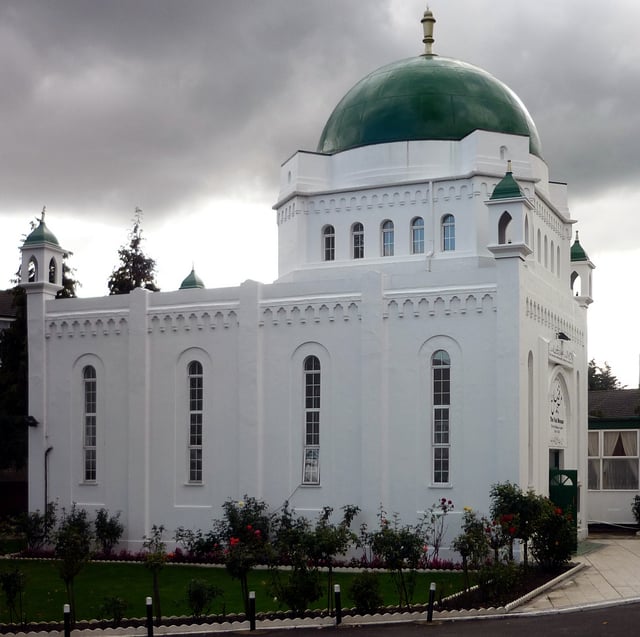
The Fazl Mosque, the first mosque in London, represents the current world headquarters of the Ahmadiyya Muslim Community
The principal headquarters of the Ahmadiyya Muslim Community is the city, town or place where the caliph resides. As such, since the forced exile of the fourth caliph from Pakistan in 1984, the official headquarters of the Community has been based in London, England. Although the Islamic holy cities of Mecca and Medina are acknowledged to be more sacred, Qadian is considered to be the spiritual headquarters of the Community.[132] It is believed, and prophesied, that in the future, the Ahmadiyya Caliphate will once again return to Qadian, the birthplace of Mirza Ghulam Ahmad. However, the Ahmadiyya city of Rabwah in Pakistan, since its founding on 20 September 1948 by the second caliph, after the Indian partition, coordinates majority of the organization's activity around the world. In particular, the city is responsible for, but not exclusively, the two central bodies of the Community; Central Ahmadiyya Council and the Council for 'The New Scheme'.[133][134] Another, but much smaller body, the Council for 'New Dedication', is also active. All central bodies work under the directive of the caliph.
Sadr Anjuman Ahmadiyya or the Central Ahmadiyya Council, first set up by Mirza Ghulam Ahmad in 1906, is today responsible for organizing the Community activities in India, Pakistan and Bangladesh; whereas the Anjuman Tehrik-i-Jadid or the Council for 'The New Scheme', first set up by the second caliph, is responsible for missions outside the Indian subcontinent.[133] Each council is further divided into further directorates, such as the Department of Financial Affairs, the Department of Publications, the Department of Education, the Department of External Affairs, and the Department of Foreign Missions among others.[135] Under the latter council, the Community has built over 15,000 mosques, over 500 schools, over 30 hospitals and translated the Quran into over 70 languages.[136] The Anjuman Waqf-i-Jadid or the Council for 'The New Dedication', also initiated by the second caliph, is responsible for training and coordinating religious teachers in rural communities around the world.
Institutions

Pakistani campus of the Ahmadiyya University in Rabwah
Of all religious institutions of the Ahmadiyya Muslim Community, Jāmi’ah al-Ahmadīyya, sometimes translated as Ahmadiyya University of Theology and Languages, is particularly notable. It is an international Islamic seminary and educational institute with several campuses throughout Africa, Asia, Europe, and North America. Founded in 1906 as a section in Madrassa Talim ul Islam (later Talim-ul-Islam College) by Mirza Ghulam Ahmad, it is the main centre of the Ahmadiyya Muslim Community for Islamic learning and the training of missionaries. Graduates may be appointed by the Caliph either as missionaries of the Community[134] (often called Murrabi, Imam, or Mawlana) or as Qadis or Muftis of the Community with a specialisation in matters of fiqh (Islamic Jurisprudence). Some Jamia alumni have also become Islamic historians. As of 2008, there are over 1,300 graduates of the University working as missionaries throughout the world.[136]
Auxiliary organizations
There are five organizations auxiliary to the Ahmadiyya Muslim Community. Each organization is responsible for the spiritual and moral training of their members. The Lajna Ima’illah is the largest of all the organizations and consists of female members above the age of 15; Majlis Khuddamul Ahmadiyya is for male members between the ages of 15 and 40; Majlis Ansarullah is for male members above the age of 40; Nasiratul Ahmadiyya is for girls between the ages of 7 and 15; and Atfalul Ahmadiyya is for boys between the ages of 7 and 15.[134]
The Community
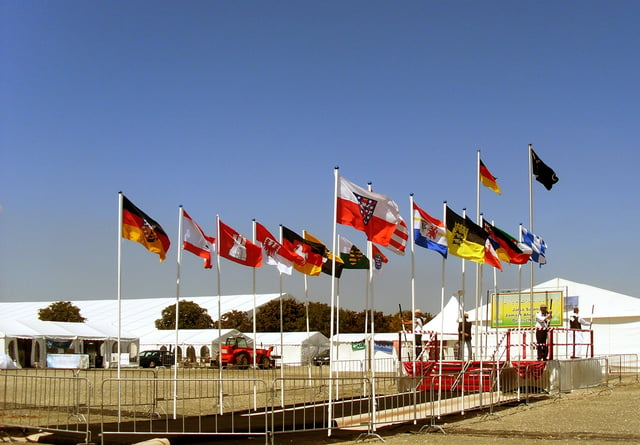
The Ahmadiyya Flag and the German flags at the 2009 German Annual Convention
The International Ahmadiyya Muslim Community is divided into National Communities, each with its National Headquarters. Each National Community is further divided into Regional Communities, which is again partitioned into Local Communities.[137] In many cases, each Local Community will have its own mosque, centre or a mission house. The Amīr, or the National President, though overseen by the central bodies of the Community, directs the National Amila or the National Executive Body which consists of national secretaries such as the General Secretary, Secretary for Finance, Secretary for Preaching, Secretary for moral Training, Secretary for Education, among others. This layout is replicated at regional and local levels with each of their own President and Executive Bodies.[134][138]
Annual events
Unlike the Muslim holidays of Eid al-Fitr and Eid al-Adha also celebrated by Ahmadi Muslims, there are several functions observed by Ahmadis though not regarded as religious holidays. As such, functions are not considered equally obligatory nor is it necessary to celebrate them on the day normally set for celebration. The most important religious function of the Community is Jalsa Salana or the Annual Convention, first initiated by Mirza Ghulam Ahmad, is the formal annual gathering of the Community, for the purpose of increasing one's religious knowledge and the promotion of harmony, friendship, and solidarity within members of the Community.[139] Other functions include "Life of the Holy Prophet Day", "Promised Messiah Day", "Promised Reformer Day" and "Caliphate Day".
Persecution
Ahmadis have been subject to religious persecution and discrimination since the movement's inception in 1889.[140] The Ahmadis are active translators of the Quran and proselytizers for the faith; converts to Islam in many parts of the world first discover Islam through the Ahmadis. However, in many Islamic countries the Ahmadis have been defined as heretics and non-Muslim and subjected to attacks and often systematic oppression.[38]
See also
List of Ahmadiyya buildings and structures
Islamic schools and branches
List of Ahmadis
Muslim Television Ahmadiyya International
